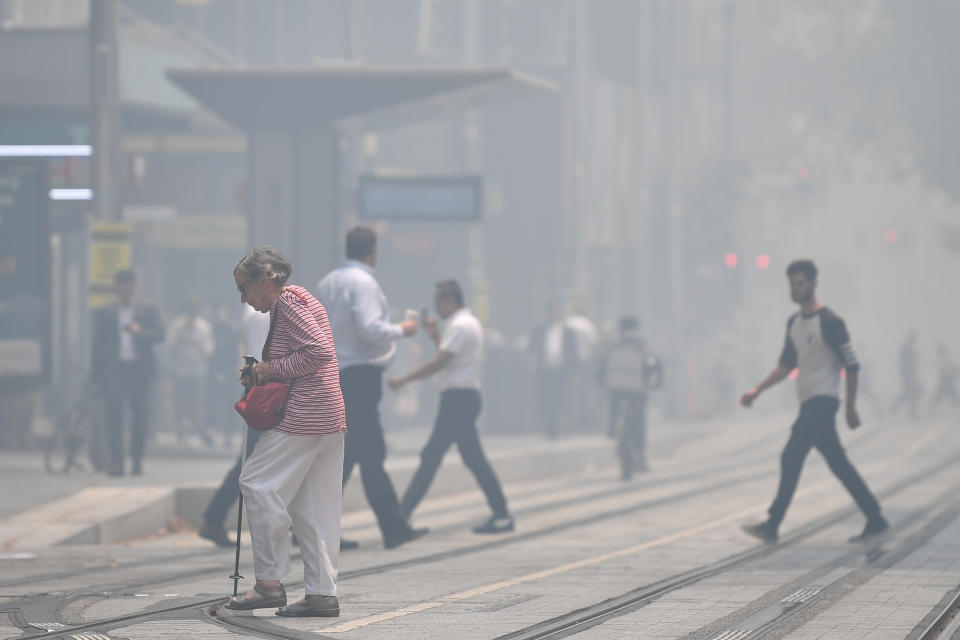Temperatures drop as southerly wind heightens fire danger
Severe fire dangers remain in place in and around Sydney as a southerly change arrived on Tuesday afternoon, pushing several fires north and easing one of the worst smoke hazes on record.
Smoke across parts of the Sydney basin is so thick that air pollution has been deemed 11 times worse than the typical "hazardous" level.
Exhausted firefighters battled the Gospers Mountain mega blaze perilously close to Sydney’s northwest suburbs where temperatures peaked to a dangerous 42C at 2pm before dropping 10 degrees in the space of an hour by 3.30pm.
The fire remains at Watch and Act level.
As the southerly change arrived in Sydney, the NSW RFS said the temperature dropped 10 degrees in just 10 minutes in some areas.

Dropping 10 degrees in 10 minutes!!! 😧
This change now pushing fires in a northerly direction.
Take care all 🔥🔥#nswfires #nswrfs #bushfiresNSW https://t.co/w3lzmxbtmf— NSW SES (@NSWSES) December 10, 2019
Ferries have been cancelled in Sydney due to the thick smoke while Sydney Trains has warned the fire alarms at train stations may be triggered.
Numerous CBD offices – including Sydney's law courts – have been evacuated due to smoke.
The Rural Fire Service headquarters at Sydney Olympic Park was also briefly evacuated due to heavy smoke in the area setting off alarms.
More than 500 fire alarms were responded to by NSW Fire and Rescue.
Unions NSW assistant secretary Thomas Costa says no workers should be forced to be on outdoor job sites amid the haze.
"Toxicity is very, very high," Mr Costa told AAP.
"(They should) tell bosses they want to leave and we're encouraging employers to let them go.”
Sydney’s air quality (or lack there of!) has reached levels that are 12 x hazardous levels. I’m not whinging about the smoke - I’m thankful to the volunteers fighting this state emergency and....... 🗳 pic.twitter.com/7mvHco3ZDh
— Matt Janssen (@matt_janssen) December 10, 2019
Sydney is again blanketed in smoke from bushfires, super-charged by climate change.
The highest hourly air quality index for Sydney East at 9-10am today was 2,214 - that is 11 times more than the threshold for "hazardous" air quality.
Keep track here: https://t.co/z0ufUFt6UW pic.twitter.com/HdzRJL0KPA— Climate Council (@climatecouncil) December 10, 2019
Exhausted firefighters may lead to ‘bad stuff’ happening
Former Fire and Rescue NSW commissioner Greg Mullins voiced his fears for the welfare of volunteers on Tuesday afternoon while himself on the way to fight a blaze at Mangrove Mountain on the state's Central Coast.
An emergency warning was issued for the fire after 1pm as almost 3000 firies battled more than 80 bushfires across NSW, with half of them uncontained.
Extraordinarily thick #smoke is combining with high #temperatures across parts of #NSW and the #ACT to create potentially hazardous health conditions. The hot weather and gusty #winds are also creating hazardous #bushfire conditions https://t.co/bsw7ffdNgA #nswfires #sydneysmoke pic.twitter.com/59wJMlvK5f
— Bureau of Meteorology, New South Wales (@BOM_NSW) December 10, 2019
As you can see here, the smoky conditions at the Green Wattle Creek fire are proving to be quite a challenge for firefighters on the ground, and in the air. #nswrfs #nswfires pic.twitter.com/FSDCgJjZQp
— NSW RFS (@NSWRFS) December 10, 2019
Mr Mullins said crews were working 12-hour shifts and with many travelling two hours each way to reach fire grounds, meaning they faced 16-hour days.
"Everyone is getting pretty worn out and, in my experience, that's where all the bad stuff happens," he told AAP.
"The troops, if they're worn out, you get to a stage where it just overwhelms everyone, so that's a worry."
Mr Mullins – who was the FRNSW boss from 2003 to 2017 – said early in the season firefighters were full of energy but as the weeks and months dragged on they reached a point of having "nothing in the tank".
"I'm buggered ... and I haven't done as many (shifts) as some people," he said.
"People will step up. Firefighters – they are men and women who give their all – they will do whatever is asked of them and more but I do fear for their welfare."
With AAP
Do you have a story tip? Email: newsroomau@yahoonews.com.
You can also follow us on Facebook, Instagram and Twitter and download the Yahoo News app from the App Store or Google Play.



